Date:
17th – 23rd August.
Themes:
Viking Age Iceland; Viking Settlements and Viking Society; Sickness,
Death and Belief in the Viking Age; Memories and Viking Identities.
Patron:
Ólafur Ragnar Grímsson, President of Iceland.
Organising Committee:
Anton Holt, Central Bank of Iceland
Gísli Sigurðsson, the Árni Magnússon Institute for Icelandic Studies
Guðmundur Ólafsson, National Museum of Iceland
Orri Vésteinsson, University of Iceland
Svavar Sigmundsson, the Árni Magnússon Institute for Icelandic Studies
Managing director: Þóra Pétursdóttir
Student assistants: Ásta Hermannsdóttir, Jakob Orri Jónsson,
Katrín Dröfn Guðmundsdóttir, Margrét Sigvaldadóttir, Sigrún Antonsdóttir
National Representatives:
Denmark: Else Roesdahl and Niels Lund.
England: Judith Jesch and Richard Hall.
Faroe Islands: Símun Arge and Eivind Weyhe.
Greenland: Claus Andreasen and Georg Nygaard
Iceland: Guðmundur Ólafsson and Svavar Sigmundsson.
Ireland: John Sheehan and Patrick Wallace.
Norway: Else Mundal and Dagfinn Skre.
Scotland: Doreen Waugh and Olwyn Owen.
Sweden: Anne-Sofie Gräslund and Henrik Williams.
Wales: John Hines.
Honorary members of the Congress:
Ólafur Ragnar Grímsson, President of Iceland
Katrín Jakobsdóttir, Minister of Education and Culture
Bergur Þorgeirsson, Director of Snorrastofa
Guðný Gerður Gunnarsdóttir, Director of the Reykjavik City Museum
Guðrún Nordal, Director of the Árni Magnússon Institute for Icelandic Studies.
Jónas Kristjánsson, Director emeritus of The Árni Magnússon Institute for Icelandic Studies
Kristín Ingólfsdóttir, Rector of the University of Iceland
Kristín Huld Sigurðardóttir, Director of the Archaeological Heritage Agency
Margrét Hallgrímsdóttir, Director of the National Museum
Ólafur Halldórsson, Member of the 3rd Viking Congress
Vésteinn Ólason, Director emeritus of The Árni Magnússon Institute for Icelandic Studies
Þór Magnússon, Director emeritus of the National Museum
Public speakers at the Congress:
Birgitta Wallace, Parks Canada
Else Roesdahl, University of Aarhus
James Graham-Campbell, University College London
Przemyslaw Urbanczyk, Polish Academy of Science, Warsaw
Thomas McGovern, Hunter College, CUNY, New York
Delegates of the Congress:
Denmark
Andres S. Dobat: Aarhus University/Moesgård Museum
Claus Feveile: Antikvarisk Samling Ribe Sydvestjyske Museer
Else Roesdahl: Aarhus University, Middelalder- og Renæssancarkæologi
Eva Andersson Strand: Centre for Textile Research, SAXO institute, University of Copenhagen
Lasse Sonne: University of Copenhagen
Lisbeth Imer: National Museum of Denmark, Runologi
Silke Eisenschmidt: Museum Sønderjylland-Arkæologi, Haderslev
Søren Sindbæk: University of York
Unn Pedersen: Aarhus University, section for Medieval and Renaissance Archaeology
England
Christina Lee: University of Nottingham, School of English Studies
Christopher Callow: Dept. of Medieval History, University of Birmingham
David Griffiths: Institute of Archaeology, University of Oxford
Dawn Hadley: Dept. of Archaeology, University of Sheffield
Gareth Williams: The British Museum
James Graham-Campbell: Institute of Archaeology, University College London
Jane Kershaw: Institute of Archaeology University of Oxford
Judith Jesch: University of Nottingham, School of English Studies
Lesley Abrams: Balliol College, Oxford
Marjolein Stern: University of Nottingham, School of English Studies
Mark Blackburn: Fitzwilliam Museum, Cambridge
Richard Hall: York Archaeological Trust
Iceland
Adolf Friðriksson: Institute of Archaeology
Anton Holt: Central Bank of Iceland
Elisabeth Ward: University of California, Berkeley
Gavin Lucas: University of Iceland
Gísli Sigurðsson: The Árni Magnússon Institute for Icelandic Studies
Guðmundur Ólafsson: National Museum of Iceland
Guðný Zoёga: Skagafjörður Heritage Museum
Guðrún Sveinbjarnardóttir: Snorrastofa & Institute of Archaeology, University College London
Gunnar Karlsson: University of Iceland
Haki Antonsson: University College London
Helgi Þorláksson: Historical Institute, University of Iceland
Hildur Gestsdóttir: University of Iceland
Jesse Byock: UCLA Mosfell Archaeological Project
Ragnheiður Traustadóttir: Háskólinn á Hólum
Rúnar Leifsson: University of Iceland
Steinunn Kristjánsdóttir: University of Iceland/National Museum of Iceland
Svavar Sigmundsson: The Árni Magnússon Institute for Icelandic Studies
Vala Garðarsdóttir: University of Iceland
Þórgunnur Snædal: Swedish National Heritage Board
Ireland
Donnchadh O'Corrain: University College Cork
John Sheehan: University of Cork, Dept. of Archaeology
Máire Ní Mhaonaigh: University of Cambridge, Dept. of Anglo-Saxon, Norse and Celtic
Patrick F. Wallace: National Museum of Ireland
Ruth Johnson: Dublin City Council
Schleswig-Holstein
Joachim Schultze: Archäologisches Landesmuseum
Sven Kalmring: Zentrum für Baltische und Skandinavische Archäologie, Schloss Gottorf
Volker Hilberg: Archäologisches Landesmuseum
Faroe Islands
Helgi Michelsen: Føroya Fornminnissavn
Símun Vilhelm Arge: Føroya Fornminnissavn
Greenland
Jette Arneborg: National Museum of Denmark
Mogens Skaaning Høegsberg: Aarhus University, Middelalder- og Renæssancearkæologi
Poul Baltzer Heide: Aarhus University, Middelalder- og Renæssancearkæologi
Sarah Croix: Aarhus University, Middelalder- og Renæssancearkæologi
Norway
Anne Pedersen: National Museum of Denmark
Dagfinn Skre: Universitetet i Oslo, IAKH
Else Mundal: Universitetet i Bergen CMS
Frans-Arne Stylegar: Fylkeskonservator i Vest-Agder
Frode Iversen: Kulturhistorisk Museum, Oslo
Ingvild Øye: Universitetet i Bergen, Inst. For arkeologi, historie, kultur- og religionsvitskap
James Knirk: Kulturhistorisk Museum, Oslo
Jón Viðar Sigurðsson: Universitetet i Oslo, IAKH
Svein Harald Gullbekk: Kulturhistorisk Museum Oslo
Sæbjørg Walaker Nordeide: Universitetet i Bergen, CMS
Scotland
Arne Kruse: University of Edinburgh, Scandinavian Studies
Barbara Crawford: Strathmartine Trust
Clare Downham: University of Aberdeen, School of Language and Literature
Colleen Batey: University of Glasgow, Dept. of Archaeology
Elizabeth Pierce: University of Glasgow, Dept. of Archaeology
Erin-Lee McGuire: University of Glasgow, Dept. of Archaeology
Julie Bond: University of Bradford, Dept. of Archaeological Sciences
Kevin Edwards: University of Aberdeen, Dept. of Geography and Environment
Neil Price: University of Aberdeen, Dept. of Archaeology
Olwyn Owen: Historic Scotland
Sweden
Anne-Sofie Gräslund: Dept. of Archaeology and Ancient History, Uppsala University
Birgitta Hårdh: Dept. of Archaeology, Lund University
Daniel Sävborg: Dept. of Scandinavian Languages, Uppsala University
Kenneth Jonsson: Stockholm Numismatic Institute
Staffan Fridell: Institutionen för nordiska språk, Uppsala
Torun Zachrisson: Archaeology & Classical Studies, Stockholm
Wales
Alan Lane: Cardiff University, Wales
John Hines: School of History and Archaeology, Cardiff
Nancy Edwards: Bangor University, Wales
Excursions:
Reykjavík, Reykjanes peninsula, Borgarfjörður, Dalir and Snæfellsnes.
Post Congress tour to North Iceland.
Sponsors:
Ministry of Educationand Culture, University of Iceland, National Museum of Iceland,
The Árni Magnússon Institute for Icelandic Studies, The Archaeological Heritage Agency,
Nordisk kulturfond, Snorrastofa, Clara Lachmanns fond, Letterstedska föreningen,
City of Reykjavík, Minjasafn Reykjavíkur, Vífilfell, Danmarks Ambassade, Reykjavík,
Norges Ambassade, Reykjavík, Sveriges Ambassad, Reykjavík, Minjasafnið á Akureyri,
Glaumbær, Centrum Hotel Reykjavík.
Congress programme
August 16 - Sunday5
| 15:00-18:00 |
Congress documents delivered in the National Museum |
|
17:00-18:00
|
Reception at the National Museum.
Welcome by Guðný Helgadóttir, Ministry of Education and Culture and
Margrét Hallgrímsdóttir Director of the National Museum of Iceland |
|
20:00
|
Public lecture in the University of Iceland, Hátíðarsalur, main building:
Birgitta Wallace, archaeologist emeritus, Parks Canada: L’Anse aux Meadows: Different Disciplines, Divergent Views |
Day 1 August 17 – Monday
Theme 1: Viking Settlements and Viking Society
| Session 1: |
Chair: Guðmundur Ólafsson |
|
09:15-10:30
|
Christopher Callow: Landnámabók and territorial organisation in Iceland
Anne Pedersen: Jelling and the Jelling Project
Kevin Edwards: Is there a Norse 'footprint' in the North Atlantic pollen record?
Discussion |
| Session 2: |
Chair: Jette Arneborg |
|
10:50-12:00
|
David Griffiths: Landscapes of power in northern and western Britain
Nancy Edwards: Viking Age Settlement and Society in North-West Wales:
the Sculptural Evidence
Andres S. Dobat: Danevirke revisited -or- how powerful were the Viking Age kings?
Discussion
|
|
12:10-13:00 |
Public lecture in Háskólatorg, lecture hall 102 - University of Iceland:
Else Roesdahl, professor in Medieval Archaeology in Aarhus, Denmark: Scandinavia in the Melting Pot, c. 950-1000 |
| Session 3: |
Chair: Kevin Edwards |
|
14:00–15:30
|
Gareth Williams: My cup runneth over.
Julie Bond: Excavations at Hamar and Underhoull, Unst, Shetland
Mark Blackburn: Torksey: Finds from the Viking wintercamp of 872/3
Richard Hall: New Discoveries in Viking Age York
Discussion |
| Session 4: |
Chair: Jón Viðar Sigurðsson |
|
16:00-17:30
|
Frode Iversen: Bona patrimonium and bona regalia. Royal manors in Scandinavia in the Viking Age
Claus Feveile: How can we define a manor from archaeological sources? A case study near Ribe, Denmark
Dagfinn Skre: Kaupang - Where did the settlers come from?
Barbara Crawford: The 'stofa'; a colonial feature of North Atlantic society
Discussion
|
|
17:40 |
Buses leave for Bessastaðir from the University of Iceland |
| 18:00-19:00 |
Reception by the President of Iceland, at Bessastaðir |
Day 2 August 18 – Tuesday
Theme 1: Viking Settlements and Viking Society
| Session 5: |
Chair: Else Roesdahl |
|
09:00-10:30
|
Joachim Schultze: Aspects of the settlement structure and house construction in Hedeby
Eva Andersson Strand: Textile Production in Hedeby and Birka
Sven Kalmring: The harbour of Hedeby
Volker Hilberg: Hedeby's fall and Slesvig's rise - continuities and changes in the 11th century
Discussion |
| Session 6: |
Chair: Helgi Þorláksson |
|
10:50-12:00
|
Frans-Arne Stylegar: Dendrochronology and Viking ships in Norway - new evidence
Ingvild Øye: Settlements and agrarian landscapes - chronological issues and archaeological challenges. Norwegian cases
Lesley Abrams: Monumental Identity: the hogback in the British Isles
Discussion
|
|
12:10-13:00
|
Public lecture in Háskólatorg, lecture hall 102 - University of Iceland: Przemyslaw Urbanczyk, professor in archaeology, Polish Academy of Science, Warsaw: Formation of the Icelandic identity viewed with the help of archaeological evidence
Congress council meeting
|
|
14:00-17:00
|
Excursion to Reykjanes
Krýsuvík - Geothermal area
Húshólmi - Viking Age farm site. The Archaeological Heritage Agency |
|
19:30-21:00
|
Reception at the Settlement Exhibition: 871 ±2. Welcome by Guðný Gerður Gunnarsdóttir, director of Reykjavik City Museum |
Day 3 August 19 – Wednesday
Theme 1: Viking Settlements and Viking Society
| Session 7: |
Chair: Richard Hall |
|
09:00-10:30
|
Clare Downham: Viking memory in the Scottish Statistical Accounts
Søren Sindbæk: Innovation and social networks in Viking period towns
Torun Zachrison: The Archaeology of Rimbert
Birgitta Hårdh: Uppåkra and Lund. A central place and a town
Discussion |
| Session 8: |
Chair: Anton Holt |
|
10:50-12:00
|
John Sheehan: Weighty matters: silver wealth distribution in Viking Age Ireland
Kenneth Jonsson: Coin circulation on Iceland and the North Atlantic
Svein Harald Gullbekk: Money and its use in the saga society
Discussion
|
|
12:10-13:00
|
Public lecture in Háskólatorg - University of Iceland: James Graham-Campbell, emeritus professor of Medieval Archaeology, University College London: 'The dragon's bed': Gold and Silver in Viking-Age Iceland - and Beyond |
Theme 2: Viking Age Iceland
| Session 9: |
Chair: Guðrún Sveinbjarnardóttir |
|
14:00-15:30
|
Jón Viðar Sigurðsson: The Free State Constitution and dispute settlement
Jesse Byock: The Longhouse at Hrísbrú in Mosfellsdalur
Haki Antonsson: Memories of the Conversion: Missionary Saints and the Christianization of Scandinavia
Guðrún Nordal: The meaning of the settlement stories in the sagas of Icelanders
Discussion
|
| 16:00-17:00 |
Visit to the Manuscript exhibition in the Culture house. |
|
17:00-18:00
|
Reception at the Numismatic collection of the Central Bank of Iceland and the National Museum |
Day 4 August 20 – Thursday
Tour to Reykholt
| 08:00- |
Departure from Reykjavik. |
| 08:30-09:30 |
Þingnes by Elliðavatn. Viking assembly site |
| 10:00-11:00 |
Hrísbrú in Mosfellsdalur. Viking age site |
| 11:30-14:00 |
Þingvellir. National assembly site |
| 14:00-15:30 |
Húsafell |
| 16:00-17:30 |
Surtshellir cave. Viking age outlaw shelter |
| 18:00-19:00 |
Hraunfossar. Waterfalls |
| 19.30 |
Reykholt |
Day 5 August 21 – Friday
Theme 2: Viking Age Iceland
| Session 10: |
Chair: Steinunn Kristjánsdóttir |
|
09:00-10:30
|
Helgi Þorláksson: A seat of a settler? - A centre of a magnate. Breiðabólstaðr and Reykholt
Guðrún Sveinbjarnardóttir: The Reykholt shieling project: some preliminary results
Gavin Lucas: Excavations at Hofstaðir
Colleen Batey: Hofstadir: can its status be determined by the artefacts?
Discussion |
Theme 3: Sickness, Death and Belief in the Viking Age - Parallel sessions
| Session 11A: |
Chair: Ingvild Øye |
|
10:50-12:00
|
Sæbjørg Walaker Nordeide: Where did all the people go? Looking for burials from the 11th century
Dawn Hadley: Protecting the dead in Viking-Age England
Silke Eisenschmidt: The graves from Hedeby
Discussion |
| Session 11B: |
Chair: Judith Jesch |
|
10:50-12:00
|
Else Mundal: Death as omen in Sagas of Icelanders
Daniel Sävborg: Haugbúar, haugbrot and sagas
Christina Lee: Sickness and society in Old Icelandic sources
Discussion
|
|
12:10-13:00
|
Public lecture: Thomas McGovern, professor, Hunter College, CUNY, New York: Vikings in the International Polar Year: bloodthirsty, sustainable, and educational |
| Session 12: |
Chair: Adolf Friðriksson |
| Theme 4: |
Memories and Viking Identities |
|
14:00-15:30
|
Donnchadh O'Corrain: Irish annals and ON texts: examples
John Hines: Raiding and Trade along the Bristol Channel in the Ninth, Tenth and Eleventh Centuries
Máire Ní Mhaonaigh: What Vikings became: the transformation of Vikings in Medieval Irish Literary Texts
Neil Price: Pirates of the Atlantic: revolution and resistance in the Viking Age
Discussion |
| Session 13: |
Chair: Olwyn Owen. Mixed themes |
|
16:00-17:30
|
Steinunn Kristjánsdóttir: The Vikings as a Diaspora - Cultural and Religious Identities in Early Medieval Iceland
Staffan Fridell: Graphic variation and change in the younger futhark
James Knirk: The Viðey rune-stick: Iceland's earliest runic inscription
Þórgunnur Snædal: What kind of name is Jafnakollr? A newly found runic inscription in Sweden and a by-name in Landnámabók
Discussion
|
|
17:30-18:30 |
Reykholt - historic walk: Geir Waage and Guðrún Sveinbjarnardóttir |
Day 6 August 22 – Saturday
Tour to Snæfellsnes
| 09:00-11:00 |
Eiríksstaðir. Viking age farm site and reconstructed hall |
| 11:00-14:00 |
Bus to Stykkishólmur |
| 14:00-16:00 |
Boat trip on Breiðafjörður |
| 16:00-18:00 |
Borg - Reykholt |
| 18:00-19:30 |
Congress Council Meeting |
| 20:00- |
Congress dinner |
Day 7 August 23 – Sunday
Mixed themes
| Session 14: |
Chair: John Sheehan |
|
10:00-11:30
|
Anne-Sofie Gräslund: Similarities or Differences - Reflections on Viking Identity
Mogens Skaaning Høegsberg: Indications of identity? The cultural identity of the Greenland Norse
Lisbeth Imer: Ave Maria – Christian runic inscriptions from Greenland
Discussion |
| Session 15: |
Chair: Colleen Batey |
|
11:50-13:30
|
Olwyn Owen: Norse influence at Govan on the Firth of Clyde
Gunnar Karlsson: Love in Early Iceland
Judith Jesch: The Norse Gods in England
Adolf Friðriksson: Viking Archaeology in Iceland – Another Half Century
Discussion
Invitation to the next congress/End of Congress
|
| 15:00 |
Bus leaves for Reykjavík |
| 16:30-17:30 |
Bus to hotels in Reykjavík or Keflavík |
Post-Congress tour to North Iceland
| 15:00 |
Bus leaves for Post-Congress tour |
| 17:30-18:30 |
Borgarvirki. Natural hillfort, Viking age remains |
| 20:00 |
Hólar í Hjaltadalur |
Day 1 August 24 – Monday. Skagafjörður
| 10:00-11:00 |
Hegranes. Medieval assembly site |
| 11:00-12:00 |
Keldudalur, archaeological site |
| 12:00-12:30 |
Víðimýri. Small turf church |
|
12:30-15:00
|
Glaumbær. Large turf farm - Archaeological site. Welcome by Guðný Zoëga from the Skagafjörður Museum |
| 15:00-16:30 |
Kolkuós. Medieval harbour |
| 16:30-19:00 |
Hofstaðir, Hólar Archaeological site, and Auðunarstofa |
Day 2 August 25 – Tuesday. Eyjafjörður
| 08:00-09:00 |
Breakfast |
| 09:00-10:00 |
Möðruvellir in Hörgárdalur |
| 10:00-12:00 |
Gásir. Medieval trading place |
| 12:00-14:00 |
Akureyri and Akureyri City Museum |
| 14:00-15:00 |
Laufás |
| 15:00-16:00 |
Goðafoss |
| 16:00-18:00 |
Hofstaðir. Viking/Early medieval site |
| 18:00-19:00 |
Narfastaðir in Reykjadalur - Dinner |
| 20:00 |
Mývatn geothermal baths |
Day 3 August 26 – Wednesday. Mývatnssveit
| 09:00-10:00 |
Námaskarð. Geothermal area |
| 10:00-12:30 |
Dimmuborgir. Lava formations/Höfði |
|
12:30-14:00 |
Þverá í Laxárdal. Old turfhouse farm |
| 14:00-15:00 |
Grenjaðarstaður. Old turfhouse farm |
| 15:00-17:00 |
Bus to Akureyri |
|
17:00-18:00 |
Dinner – BBQ garden party in Akureyri. End of Post Congress tour |
| 18:00-24:00 |
Bus to Reykjavík or |
| 18:00-19:00 |
Flight to Reykjavík |
| 24:00-01:00 |
Bus to hotels in Reykjavík or Keflavik |
Notes:
Minutes of the Viking Congress Council meeting at Reykholt,
August 23. 2009
Present were: Judith Jesch and Richard Hall from England, Else Roesdahl and Anne Pedersen from Denmark, Anne-Sofie Gräslund from Sweden, Else Mundal from Norway, Jette Arneborg from Greenland, Colleen Batey and Olwyn Owen from Scotland, John Sheehan from Ireland, John Hines from Wales, Guðmundur Ólafsson and Gísli Sigurðsson from Iceland.
Guðmundur chaired the meeting and led the discussion of the organization of the Viking congress as described in a document that was circulated on December 3rd 2008 and had been presented and discussed at previous meetings. The first 6 chapters were accepted as a truthful description of the congress until now and the remaining paragraphs were passed in the attached form as a base for the next congress.
Some discussion was on if the congress should open up to other countries and a larger group of people but it was agreed to continue with similar limitations but national representatives and congress organizers were urged to use their present external quotas to invite scholars from other countries. It was left to the individual national committees to select their representatives as they see fit with an emphasis on the multidisciplinary nature of Viking studies.
Else presented a letter, which suggested a joint conference with the Saxon symposium. The council did not approve of this suggestion and Else was asked to write back, informing of this decision.
Finally the council accepted an invitation from the Shetlands, presented by Olwyn Owen, to host the next Viking Congress in 2013.
Gísli Sigurðsson, secretary
Congress Diary:
|

|
Delegates arrived in Reykjavík on Sunday, August 16th 2009. At 17:00 they were welcomed by Guðný Helgadóttir, from the Ministry of culture and education, and Margrét Hallgrímsdóttir, director of the National Museum, in a reception at the National Museum of Iceland. Following the reception, at 20:00, Birgitta Wallace, archaeologist emeritus at Parks Canada, opened the congress by giving the first lecture in the University’s Main building. The lecture, on L’Anse aux Meadows research project, was the first of five public lectures and was well attended. |
|
Many members of the Viking Congress gathered outside th University of Iceland.
|
|
|
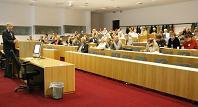 |
|
Members of the Viking Congress in the lecture hall at the University of Iceland. | |
Formal proceedings began early the following morning, August 17th, with a formal opening speech by Mr. Ólafur Ragnar Grímsson, President of Iceland and Patron of the 16th Viking Congress. This was followed by a busy day of lectures on the theme “Settlements and Viking Society”. At 12:00 Else Roesdahl, professor in Medieval Archaeology at Aarhus University, gave the second public lecture, entitled “Scandinavia in the Melting Pot, c. 950-1000”. |
|
|
|
|
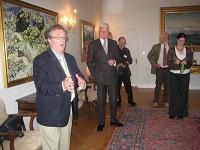 |
The first day was closed with a reception at Bessastaðir, the presidential residency, hosted by Mr. Ólafur Ragnar Grímsson. The President gave a talk, welcoming the guests, and before leaving Patrick Wallace said a few words and thanked the President on behalf of the congress delegates. When back in central Reykjavík many of the participants proceded with the social program at the congress bars, Fjalakötturinn and Uppsalir.
|
|
Patrick Wallace thanking Mr. Ólafur Ragnar Grímsson for inviting the Viking Congress to Bessastaðir.
|
|
|
|
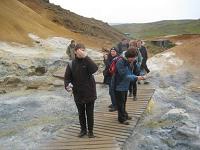
|
|
Viking Congress members had
mixed feelings about the smell of
the pure geothermal air at Seltún. |
|
On Tuesday morning papers were still devoted to the first theme of “Settlements and Viking Society”. At noon Przemyslaw Urbanczyk, professor of archaeology at the Polish Academy of Science in Warsaw gave a public lecture on the formation of an Icelandic identity based on archaeological information. After lunch at the University’s canteen Háma, and a hasty group-photo opportunity, two buses left for an excursion to Krýsuvík and Húshólmi south of the capital.
The first stop was at the Seltún geothermal area in Krýsuvík, where participants enjoyed the smell of sulphur and spectacular scenery of boiling water and mud springs. From Seltún the the journey continued on decent roads for a few kilometres when suddenly the buses proceded onto a narrow mud track leading, along the edge of the lavafield, towards the southern shoreline in the distance. For a critical hour, or so, it was uncertain whether or not all participants, or in fact the buses, would make it to the end. |
|
|
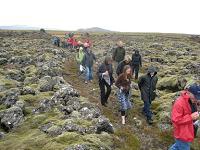
|
|
The long walk on the old road through the Ögmundarhraun lavafield was a challenge. |
|
Beyond all hope, however, after several incidents, both buses succeded and participants were welcomed by Agnes Stefánsdóttir, from the Archaeological Heritage Agency of Iceland, who escorted the parade into the lavafield towards Húshólmi. After a refreshing walk through the rough lava in the authentic weather of the south coast, participants were rewarded with a warm welcome and refreshments, in the form of fermented shark and Icelandic brennivín, by Kristín Huld Sigurðardóttir, Kristinn Magnússon and Gunnar Bollason, at the AHA’s mobile bar. While enjoying the traditional delicacies, Agnes explained the archaeology and nature of the buildings in the lavafield at this Viking age site.
|
|
|
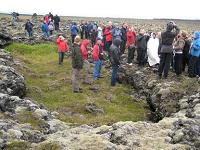
|
|
The Viking age ruins in the middle
of the lavafield were the reward
for a long walk. |
|
From Húshólmi the drivers again managed the impossible and the whole group was delivered safely to the Reykjavík 871±2 Museum in central Reykjavík, where the Reykjavík City Museum hosted a reception. A welcoming talk was given by Guðný Gerður Gunnarsdóttir, director of the Reykjavík City Museum, and after enjoying the museum’s outstanding exhibition James Knirk thanked her and her staff for the wonderful reception on behalf of the guests. Afterwards many of the participants continued socializing at the congress bar conveniently located above the museum.
|
|
|
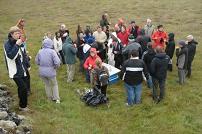
|
|
Enjoyable break at Húshólmi,
hosted by the Archaeological
Heritage Agency. |
|
Wednesday, August 19th, was a day fully packed with lectures starting early in the morning. Before lunch break lectures were devoted to the theme “Settlements and Viking Society”, while after lunch to the theme of “Viking Age Iceland”. At noon James Graham-Campbell, professor emeritus of Medieval Archaeology at University College London, gave a public lecture on silver hoards from Viking Age Iceland. Lectures went on until 15:30 in the afternoon when the social program took over and delegates attended the Manuscript exhibition in the Culture House, guided by Gísli Sigurðsson. After an interesting visit the street was crossed to attend a reception at the Central Bank of Iceland,and The National Museum’s Numismatic Collection. Anton Holt, curator at the banks’ collection, welcomed the guests who then could look through the collection while enjoying the refreshments kindly (but ironically) provided by the bank. Again the socializing proceded at the congress bar into the night. |
|
|
|
|
|
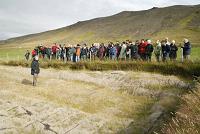
|
| Jesse Byock in the large excavated Viking age hall at Hrísbrú. |
|
On the fourth day, Thursday August 20th, the congress moved its venue from the capital of Reykjavík to the medieval centre of Reykholt, home to chieftain and writer Snorri Sturluson. After being loaded with luggage, food and other Viking-necessities the buses left Reykjavík early in the morning. The first stop on the way was made in the outskirts of the city, at Þingnes by lake Elliðavatn, perhaps the earliest assembly site in Iceland.
After Guðmundur Ólafsson had explained the site, the buses stopped at Hrísbrú in Mosfellsdalur, where Jesse Byock described the Viking-age site and explained the Mosfell project.
|
|
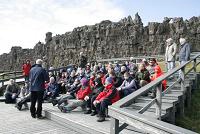 |
At Þingvellir the Congress was welcomed by Einar Á. E. Sæmundsen, the interpretive officer of the National Park, who gave a presentation and an excellent guided tour of the World Heritage Site.
|
|
Einar Sæmundsen lectures the Congress by the Law rock at Þingvellir assembly site.
|
|
|
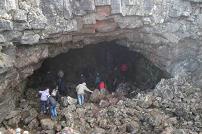 |
From Þingvellir the tour went on over a rocky mountain road to the Surtshellir cave, where surprisingly many dare-devils followed, at their own risk (!), Guðmundur Ólafsson in a truly adventurous trip deep into the lava cave, to see the unique Viking Age remains. Fortunately, despite a few close calls, no one got seriously injured. |
|
Eager delegates of the Viking
Congress disappear into the deep
dark Surtshellir cave.
|
|
|
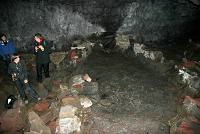
|
|
|
Houseruin and pile of bones at the
Viking age outlaw shelter in the
Surtshellir cave.
|
|
|
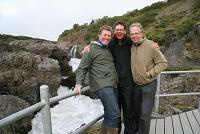 |
Finally the buses stopped at the beautiful Hraunfossar and Barnafoss waterfalls before entering Reykholt. After a chaotic and at times almost fatally stressful checking inn at the hotel all participants were privileged with a bed to sleep in, and the formal program could proceed.
|
|
Svein H. Gullbekk, Mark Blackburn
and Kenneth Jonson at the Barnafoss
waterfall.
|
|
|
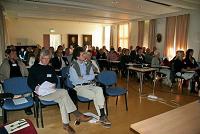 |
Friday the 21st was filled with lectures all day, devoted to all themes. At noon, Thomas McGovern, professor at Hunter College, CUNY, New York, gave a public lecture about Vikings in the International Polar Year: bloodthirsty, sustainable and educational.
|
|
The lecture hall in Reykholt.
|
|
|
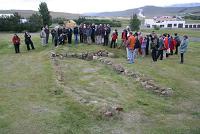 |
After the day’s sessions Guðrún Sveinbjarnardóttir gave a tour of the archaeological site of Reykholt and The Rev. Geir Waage gave an insight into the history of Reykholt. In the exhibition locales under the church.
|
|
Guðrún Sveinbjarnardóttir with the Congress on top of the excavated farmmound in Reykholt.
|
|
|
|
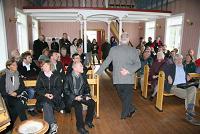
|
| Rev. Geir Waage vith the Viking Congress in the old Church of Reykholt. |
|
|
|
|
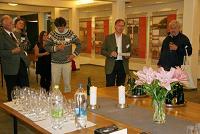
|
|
Bergur Þorgeirsson welcomes
the Viking Congress to Snorrastofa. |
|
Bergur Þorgeirsson, director of Snorrastofa, introduced Snorrastofa to the Congress while delegates enjoyed red and white wine generously donated by the Danish, Norwegian and Swedish embassies – and other Viking beverages. Afterwards the Reykholt Church choir gave a most memorable concert in the Reykholt church.
After a lovely dinner at the Reykholt hotel restaurant the socializing continued at the hotel bar (and not in Snorralaug) into the night. |
|
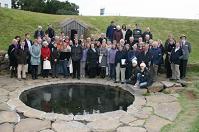 |
On Saturday the 22nd the Congress went on a Saga trail to Snæfellsnes peninsula and Breiðafjörður fjord. The first stop was at Eiríksstaðir, where the archaeology of the site and the reconstructed hall of Eirikur the Red’s farm were explained by Sigurður Hrafn Jökulsson, the keeper of the site, and Guðmundur Ólafsson.
|
|
The Viking Congress at Snorri’s pool
in Reykholt.
|
|
|
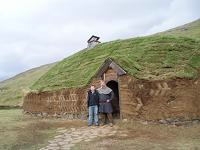 |
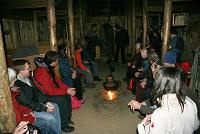
|
|
Guðmundur Ólafsson and Sigurður
H. Jökulsson outside the recon-
structed farm at Eiríksstaðir.
(Foto Else Roesdahl). |
In the reconstructed Viking age hall
at Eiríksstaðir.
|
|
|
|
|
|
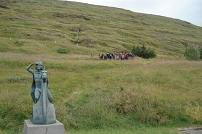
|
| The Viking Congress gathered by the ruin of the Viking age hall. A statue of young Leifur Eiriksson in the foreground. |
|
On the bus, driving through the Saga landscapes between stops, congress members were entertained with appropriate passages from the Sagas read by a carefully selected group of readers. After lunch at Hotel Stykkishólmur, the congress delegates had the opportunity to walk around the town during the interesting local festival of “Danish Days” until it was time to board the boat for a trip around Breiðafjörður fjord, noted for its rich bird life, beautiful rock formations and many historical sites. Delicious seafood was hauled in and, in contrast to national tradition, enjoyed fresh with a glass of good wine. |
|
|
|
|
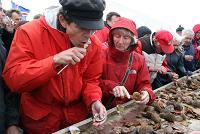
|
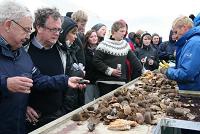 |
|
|
|
|
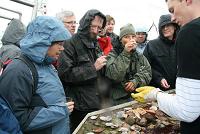 |
Members of the Viking Congress
eagerly taste the fresh catch of
seafood on board.
On the journey back towards Reykholt a short stop was made at Borg, where John Hines read Egill Skallagrímsson´s poem Sonatorrek.
|
|
|
|
|
|
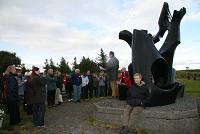
|
|
At the farm Borg, John Hines cites
the poem Sonatorrek by the large
sculpture bearing the same name. |
|
Back in Reykholt the Congress Council met for a second brief meeting to discuss the draft version for the Organisation of the Congress as well as accepting an invitation from Scotland to host the next congress.
The Congress Dinner, enjoyed at the Reykholt hotel restaurant, included several surprise performances and talks. Afterwards all delegates, as well as the staff of Snorrastofa and Reykholt church, were invited to a Viking-party at the old school building where they once again enjoyed surprising amounts of Viking brew in cans and bottles, now well familiar to all delegates. After discussing the matter of bathing with The Rev. Geir Waage a joint verdict was that bathing in Snorri’s laug was “not allowed – but not forbidden”. Socializing thus continued at various locations on the Reykholt manor into the night and early morning.
Sunday 23rd, the last day of the Congress continued with presentations, under mixed themes, until lunchtime. After a common lunch the Congress ended with a formal invitation by Olwyn Owen to the next Viking Congress in Shetland in 2013.
At 14.00 most Congress delegates went back to Reykjavik, while a brave flock of some 30 people, equipped with a still surprising amount of Viking brew, took the Post Congress Tour bus to North Iceland. After a stop at the natural hill forth of Borgarvirki, the group got a well deserved rest at Hólar in Hjaltadalur, bishopric of Northern Iceland. |
|
|
|
|
|
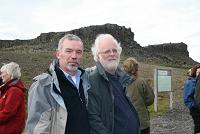
|
|
Else Roesdahl, John Sheehan and
James Graham-Campbell heading
for the Borgarvirki hillforth. |
|
On the following morning the flock awoke to heavy rain and dark skies at Hólar. A few brave souls, despite this, began the day with a horribly cold bath in the Holar swimming pool. After referring with the guides of the day, Ragnheiður Traustadóttir, director of the Hólar Archaeological Project, archaeologist Jennica Einebrant Svensson and Guðný Zoёga, head of the Archaeological department of the Skagafjörður Museum, the programme was rearranged and the result was that all sites were visited in good and dry weather.
The old local assembly at Hegranes, and the Keldudalur site were visited under the guidance of Ragnheiður, Jennica and Guðný. At Víðimýri turf church Einar Örn Einarsson, keeper of the church, showed the group around and after a lovely lunch at Áskaffi in Glaumbær, the group was welcomed to the Glaumbær museum by Guðný Zoёga on behalf of Museum director Sigríður Sigurðardóttir. |
|
|
|
|
|
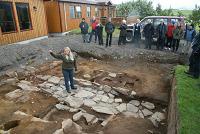
|
|
Ragnheiður Traustadóttir in the medieval byre, excavated at Keldudalur. | |
In the afternoon Ragnheiður lead the group to the medieval harbour at Kolkuós, the reconstructed medieval Auðunarstofa and the archaeological sites at Hólar as well as the Viking age remains at Hof in Hjaltadalur. After dinner many spent the evening at the archaeological lab at Hólar. Some explored the turf house farm at Hólar, with torches, and experienced the darkness in these old dwelling houses.
|
|
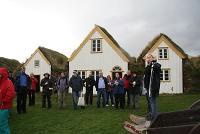 |
 |
|
Guðný Zoëga in front of the Glaum-
bær turfhouse farm points out the
Viking age farm-site. |
The Post Congress tour at the medie-
val harbor at Kolkuós. The eroded
excavation site is in the background. |
|
|
|
|
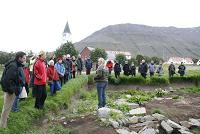 |
On the 25th the tour went on to Eyjafjörður. A first stop was made at the medieval monastery site Möðruvellir where Professor Bjarni E. Guðleifsson welcomed the group in the Möðruvellir church and introduced it to the history of the farm and manor.
|
|
Ragnheiður Traustadóttir on the main excavation site of the Hólar project.
|
|
|
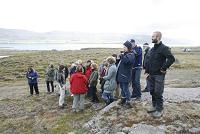 |
After enjoying coffee and “kleinur” at the old Möðruvellir theatre the journey continued to the medieval harbour at Gásir where Þóra Pétursdóttir explained the site and the Gásir excavation project.
|
|
Þóra Pétursdóttir prepares the group for a tour at Gásir, the medieval harbor site.
|
|
|
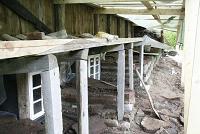 |
Haraldur Þór Egilsson, director of the Akureyri Museum, welcomed the group to the Akureyri city Museum. After a picnic lunch in the Museum garden Haraldur introduced the museum exhibitions. Before leaving Akureyri the group had a quick stroll through the town centre. From Akureyri the bus headed for Mývatnssveit with a short stop at the old Laufás turf house farm and Goðafoss waterfall. |
|
At Laufás turfhouse farm, repairs
of an old turf wall could be seen.
|
|
|
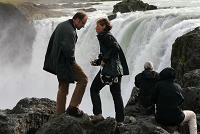 |
At Hofstaðir Adolf Friðriksson presented the excavations of the large Viking age hall, pit house and other remains at the site.
|
|
John Hines and Torun Zachrisson
in an intense discussion at the
Goðafoss waterfall.
|
|
|
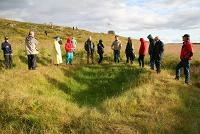 |
After a fantastic dinner buffet dinner at Narfastaðir guesthouse in Reykjadalur, many participants went for a visit to the geothermal baths in Mývatnssveit to relax their weary bones. Some wished they could have stayed there longer…perhaps forever.
|
|
Adolf Friðriksson points out the large pithouse at Hofstaðir in Mývatnssveit, accompanied by some Congress delegates and large swarms of flies.
|
|
|
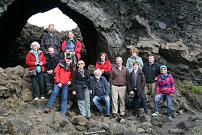 |
On Wednesday August 26th, the last day of the Post Congress Tour, the unusual and dramatic lava formations at Dimmuborgir and the smelly geothermal area at Námaskarð were visited.
|
|
An energetic group made it all the
way to the Elf-church in Dimmuborgir.
|
|
|
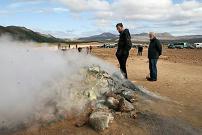 |
Leaving the Mývatnssveit area the tour headed towards Laxárdalur through the Hólasandur sand desert where the beautiful old turf house farm at Þverá in Laxárdalur, with the indoor creek, was inspected.
|
|
Daniel Sävborg and James Graham-Campbell study a steaming pile of stones at Námaskarð. |
|
|
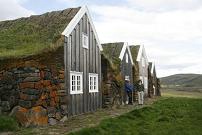 |
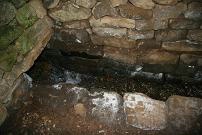 |
|
The farmer Áskell Jónasson and Þóra
Pétursdóttir in frornt of the old farm
at Þverá in Laxárdalur. |
Part of the small fresh water creek
that runs through the turfhouse
farm at Þverá, for cooling the milk
in the dairy. |
|
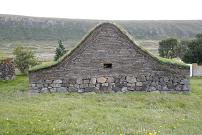 |
|
|
A beautifully proportioned and well
built gable of one of the turfhouses
at Þverá.
|
|
|
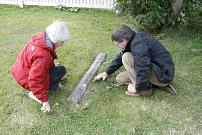 |
After a short stop at Grenjaðarstaður turf farm the group headed back to Akureyri where the Post Congress Tour came to a formal end with a garden party and BBQ at Þóra’s in-laws’.
|
|
Else Roesdahl and Mark Blackburn discover an old gravestone with runic inscription at Grenjaðarstaður.
|
|
|
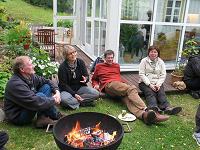 |
Some took the plane back to Reykjavík, while most of the participants went with the bus and arrived in the capital around midnight. Many even got a few hours sleep before catching the flight early in the morning, bringing them back to “normal life”.
|
|
Exhausted but happy delegates at
the end of the Post Congress Tour
in Akureyri.
|
|
|
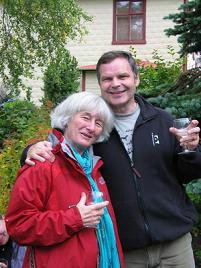 |
|
|
|
|
|
Með góðum kveðjum frá Íslandi!
Anton Holt
Gísli Sigurðsson
Guðmundur Ólafsson
Svavar Sigmundsson
Þóra Pétursdóttir |
|
Congress Proceedings:
All Congress speakers are invited to remit a manuscript for The Proceedings of the 16th Viking Congress. Manuscripts should be delivered by the end of December 2009. The manuscripts will be peer-reviewed and selected papers will be published. Each article can be up to 10 pages in length, inclusive of illustrations. Public speakers will be given up to 15-20 pages.
The aim is to publish the Proceedings of the Congress at the end of 2010 or in early 2011. Citations and references shall be used according to the APA-style, 5th edition. Information about the APA-style is available on the Internet, such as: http://www.liu.edu/cwis/cwp/library/workshop/citapa.htm
All manuscripts (and questions) shall be sent to Svavar Sigmundsson (svavar@hi.is). |